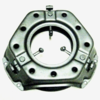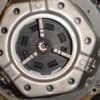quote:
Originally posted by 1Rocketship:
[QUOTE]Originally posted by David_Nunn:
I also have a Mustang clutch in my Pantera and it works beautifully. It's a McLeod 10.5", 2,600 lb, diaphragm pressure plate with an aluminum friction ring (pt.#: 360048-5A) on a Mustang, 157 tooth, aluminum flywheel.
A Pantera flywheel is 164 teeth.
When using a 157 teeth flywheel does a corresponding 157 teeth starter need to be used?!
DeTomaso Pantera 1971, 1972, 1973, 1974 Base 5.8L V8 GAS Naturally Aspirated CARB H Aluminum Flywheel; 164 Teeth; Weight 34.3 lbs.; w/Counter Balance;
10.4 in. Pantera Conversion Clutch Size; Evenly Spaced Bolt Pattern~ 11 3/8 in. Between Bolt Holes Directly Across From Bolt Hole Centers
DeTomaso Pantera 1971, 1972, 1973, 1974 Base 5.8L V8 GAS Naturally Aspirated CARB Aluminum Flywheel; 164 Teeth; Weight 34.3 lbs.; w/Counter Balance;
11 3/8 in. Between Bolt Holes Directly Across From Bolt Hole Centers~ 10.4 in. Pantera Conversion Clutch Size; Evenly Spaced Bolt Pattern
DeTomaso Pantera 1971 164 Teeth; Weight 34.3 lbs.; w/Counter Balance;
11 3/8 in. Between Bolt Holes Directly Across From Bolt Hole Centers~ 10.4 in. Pantera Conversion Clutch Size; Evenly Spaced Bolt Pattern
DeTomaso Pantera 1972 164 Teeth; Weight 34.3 lbs.; w/Counter Balance;
11 3/8 in. Between Bolt Holes Directly Across From Bolt Hole Centers~ 10.4 in. Pantera Conversion Clutch Size; Evenly Spaced Bolt Pattern
DeTomaso Pantera 1973 164 Teeth; Weight 34.3 lbs.; w/Counter Balance;
11 3/8 in. Between Bolt Holes Directly Across From Bolt Hole Centers~ 10.4 in. Pantera Conversion Clutch Size; Evenly Spaced Bolt Pattern
DeTomaso Pantera 1974 164 Teeth; Weight 34.3 lbs.; w/Counter Balance;
11 3/8 in. Between Bolt Holes Directly Across From Bolt Hole Centers~ 10.4 in. Pantera Conversion Clutch Size; Evenly Spaced Bolt Pattern
DeTomaso Pantera 1981, 1982, 1983, 1984, 1985 GT5 5.8L V8 GAS Naturally Aspirated CARB Aluminum Flywheel; 164 Teeth; Weight 34.3 lbs.; w/Counter Balance;
10.4 in. Pantera Conversion Clutch Size; Evenly Spaced Bolt Pattern~ 11 3/8 in. Between Bolt



